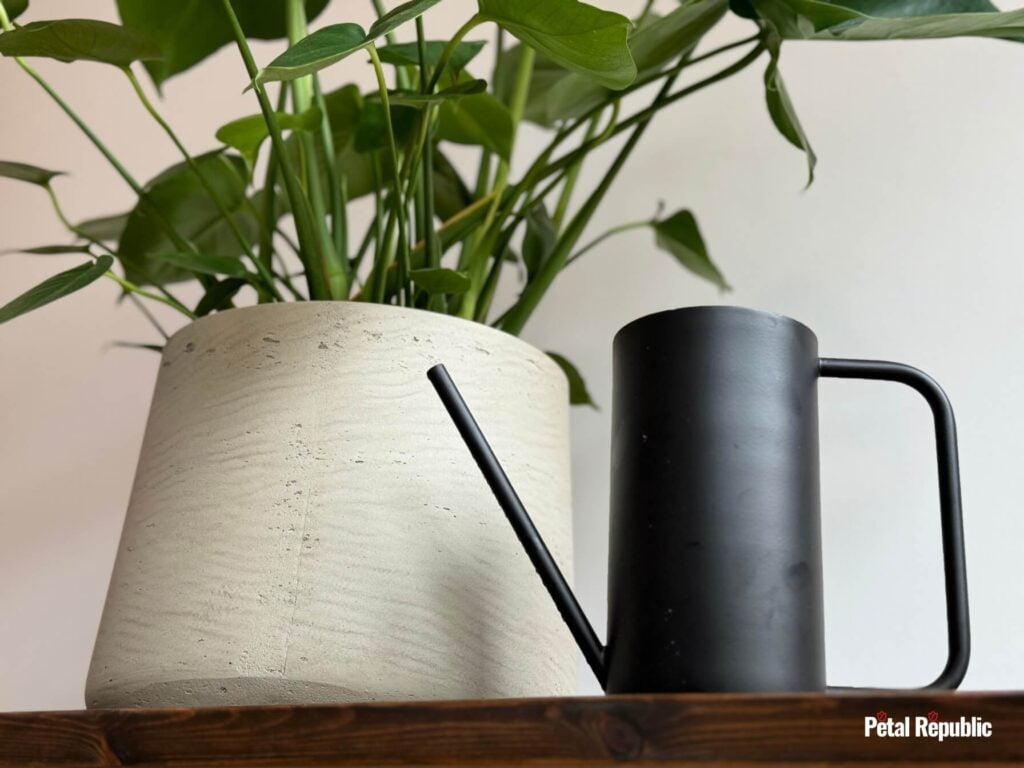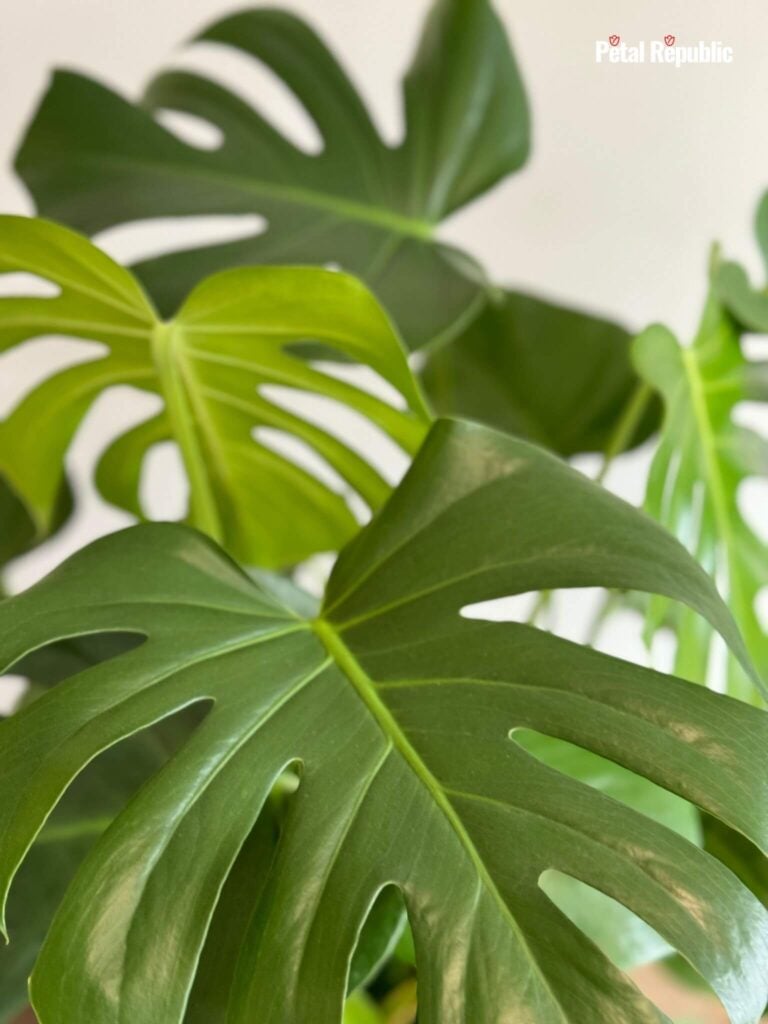12 Reasons Your Monstera Leaves Are Turning Yellow (And How To Fix It)
Monstera plants are undeniably among the most popular houseplants around. Unfortunately, they don’t always look as good as they do on Pinterest, frequently encountering problems including yellowing leaves. In this guide, I’ll run through 12 things that may leave your Monstera’s leaves turning yellow and the quickest way to fix or prevent the problem.

Why Are My Monstera Leaves Turning Yellow?
Like all plants grown at home, finding the correct balance of light, temperature, watering, and feeding is imperative to ensure your Monstera thrives. Monstera leaves turning yellow is a common sign that one of these elements is out of balance – be it overwatering, underwatering, prolonged or insufficient exposure to light sources, lack of nutritional supplements in the soil base, or shock caused by repotting or propagation.
1) Watering Considerations

Here’s a fail-proof way to nurture a houseplant – proper watering. It’s a simple step in plant care, but doing it the wrong way results in more harm to your Monstera than you can imagine.
When Monstera leaves are turning yellow, one of the most common culprits is overwatering. These plants do not do respond well to improper soil moisture or ‘wet feet’. Often, it leads to yellowing of the leaves, root rot, and eventually death of the plant.
To avoid this, water your Monstera properly by deep watering when the top 2 to 3 inches of topsoil is dry. Provide sufficient moisture so that the water flows from the drainage hole.
On the other hand, yellowing leaves can also be caused by underwatering and excessively dry soil. When there is not enough water in the soil, the plant cannot draw up nutrients or photosynthesize. A result of this is the lack of chlorophyll, which causes the leaves to turn yellow. Often, the yellow leaves also exhibit yellow and brown spots on monstera plants.
2) Light Conditions

This tropical plant is native to tropical regions of the Americas and thrive best in bright indirect sunlight. The leaves of these crowd-favorite houseplants can burn if placed in direct sunlight for a long period, turning brown in the areas exposed to the light.
Lack of sunlight, on the other hand, can result in yellow Monstera leaves. Avoid low-light rooms with only north-facing or no windows, and give your plant a full day of bright indirect light to improve conditions.
3) Temperature and Humidity
Temperature and humidity are also potential causes of yellow Monstera leaves. Low humidity causes the browning of leaf edges, followed by a whole yellowing leaf. You can increase the humidity by using a water-filled tray with stones beneath your plant’s pot or using a humidifier.
Since Monsteras are tropical houseplants, extreme temperatures and sudden temperature changes also often cause yellow, drooping leaves. Avoid this by moving your plant to a warmer spot away from any cold drafts.
4) Pest and Diseases
Indoor plant leaves, in general, often turn yellow because of pests and diseases. Damaged plants exhibit yellowing of the leaves in yellow spots when sap-sucking insects like aphids, mealybugs, fungus gnats, or even a spider mite feed on them. Diseases like powdery mildew can also cause a host of growth problems that result in yellow leaves. Monitor your Monstera for any sign of pest or disease problems and address them as necessary.
One easy way to control the most common houseplant pests is by spraying the affected plants with a soap-water solution. You can also use neem oil to get rid of pests.
5) Fertilization
Yellowing leaves could be a symptom of excessive or lack of plant fertilization. Too much fertilizer causes high concentrations of soluble salts and minerals, altering the soil pH. As a result, the leaves wilt and turn yellow, and the leaf margins turn brown. Yellowing leaves can also indicate under-fertilization or nutrient deficiency in Monsteras.
For best results, fertilize your plants using a balanced, water-soluble fertilizer at half-strength once a month during the growing season.
6) The Soil Mix

Choosing the right soil mix for your Monstera deliciosa is another crucial factor affecting growth. The plant prefers well-draining soil that allows oxygen to reach the roots. Thus, planting it in a heavy, soggy soil mix often leads to a Monstera leaf or two yellowing.
If you think the soil moisture is causing the problem, repot your monstera plant using a good aroid mix or add some perlite or orchid bark to potting soil to improve the soil conditions.
7) Potting Container
A container with drainage holes is a must for Monstera plants. Drainage holes prevent waterlogging and avoid soggy conditions that result in yellow leaves and root rot.
The size of the pot is also something to take into consideration. When you use a pot that’s too big for your plant, there will be too much space in the pot for the roots to fill, leaving the excess soil moist and leading to root rot.
8) The Seasons
Seasons, like other external factors, can also indirectly cause yellow leaves of Monstera plants. For example, the soil dries slower in winter, and as a result, the plant is more prone to overwatering. Changes in seasons also lead to changes in temperatures that can cause yellowing leaves too.
Try to keep your indoor conditions as consistent as possible to avoid any further yellowing.
9) The Monstera’s Age
Sometimes, a yellow leaf isn’t caused by environmental conditions or pests and diseases. As with any other plant, yellow leaves are just a part of the Monstera plant’s growth. An older leaf, usually a lower leaf, can naturally turn yellow and fall off. If so, you don’t have to worry – it is a natural process of the plant’s life cycle.
10) The Effects of Pruning
Regular pruning is a crucial step in Monstera care. Cutting off or removing damaged or dying leaves helps Monstera plants use their resources properly, preventing yellowing leaves.
Excessive pruning, on the other hand, can cause the plant to go into shock, also resulting in yellowing leaves. Never remove too much of the plant at once and cut above a node to promote new growth. Monstera plants are considered mildly toxic so it’s best to wear gloves for the job.
11) Moving the Plant to a New Location

Yellowing leaves are an indication of a stressed plant. Transferring a plant from one location to another causes major stress to houseplants like Monstera. When you move a Monstera to a new location or bring it home from a store, the plant needs time to adjust to its new environment.
As a result, some of its leaves may turn yellow and fall off. This is not a cause for concern, though. The plant will eventually recover and bounce back to its healthier state once it has adjusted.
12) Repotting
Repotting is another practice that may cause stress to Monstera plants if done improperly.
Transplant shock, which results in yellow leaves, occurs when you repot a plant at the wrong time of the year. It can also happen when you use a different type of potting mix or when you leave the roots underneath the soil (not the aerial root) exposed for a long period during transplanting.
Wrap Up
A Monstera turning yellow is a common houseplant problem. Mostly caused by poor growing conditions or incorrect care, the problem is generally easy to fix. Monitor your plants and keep an eye on early signs and symptoms that come with the yellowing leaves. Early detection of plant care issues will help your Monstera recover faster and grow healthier.
Further reading: Discover 10 things they don’t tell you about Monstera plants.
Madison is a writer and editor with a Bachelor’s degree in History and Political Science. She writes and photographs for various online and print publications in the gardening sphere and is the author of the book The Next-Generation Gardener.

